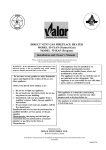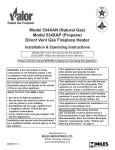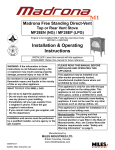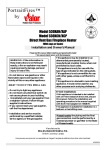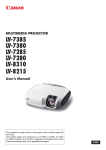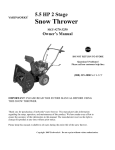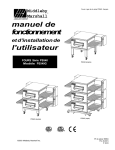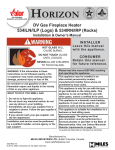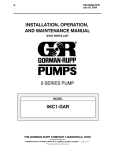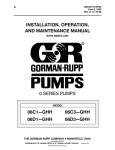Download Valor Fires 940 Owner`s manual
Transcript
Direct Vent Gas Fireplace Heaters Model 534AN (Natural Gas) Model 534AP (Propane) Installation and Owner’s Manual Please read this manual before installing and operating this heater This manual should remain with the homeowner WARNING: If the information in these instructions is not followed exactly, a fire or explosion may result causing property damage, personal injury or loss of life. - Do not store or use gasoline or other flammable vapors and liquids in the vicinity of this or any other appliance. -WHAT TO DO IF YOU SMELL GAS • • • • Do not try to light any appliance. Do not touch any electrical switch: do not use any phone in your building. Immediately call your gas supplier from a neighbor’s phone. Follow the gas supplier’s instructions. If you cannot reach your gas supplier, call the fire department. - Installation and service must be performed by a qualified installer, service agency or the gas supplier. This appliance may be installed in an aftermarket permanently located, manufactured (mobile) home, where not prohibited by local codes. This appliance is only for use with the type of gas indicated on the rating plate. This appliance is not convertible for use with other gases, unless a certified kit is used. This appliance is a domestic room heating appliance. It must not be used for any other purpose such as drying clothes etc. This appliance is suitable for installation in a bedroom or bed sitting room. CONTENTS 1. 2. SAFETY INFORMATION........................................................................................................................................................................ 3 OPTIONS..................................................................................................................................................................................................... 4 2.1. Appliance styles .................................................................................................................................................................................. 4 2.2. Optional outer trims .......................................................................................................................................................................... 4 2.3. Additional optional features ............................................................................................................................................................. 4 2.4. Venting options................................................................................................................................................................................... 4 3. GENERAL ................................................................................................................................................................................................... 6 3.1. Approvals & codes ............................................................................................................................................................................. 6 3.2. Ratings................................................................................................................................................................................................. 6 3.3. Wall Thickness .................................................................................................................................................................................. 6 4. LOCATION ................................................................................................................................................................................................. 7 4.1. Framing ............................................................................................................................................................................................... 7 4.2. Rear Vent Connection. Flat on Wall................................................................................................................................................ 7 4.3. Rear Vent Connection. Flat on Wall with Snorkel Termination.................................................................................................. 7 4.4. Rear Vent Connection, Vertical Vent Rise with Horizontal Rear Termination......................................................................... 8 4.5. Rear Vent Connection, Vertical Vent Rise with Horizontal Snorkel Termination.................................................................... 8 4.6. Corner Location, Rear Vent Connection, Horizontal Vent Run Only ........................................................................................ 9 4.7. Corner Location, Rear Vent Connection, Vertical Rise, Horizontal Termination .................................................................... 9 4.8. Rear Vent Connection, Vertical Rise, Through the Roof Termination ....................................................................................... 9 4.9. Rear Vent Connection,Vertical Rise with Offset, Through the Roof Termination.................................................................. 10 4.10. Top Vent Connection, Horizontal Rear Termination.................................................................................................................. 11 4.11. Top Vent Connection, Horizontal side termination..................................................................................................................... 12 4.12. Top Vent Connection, Horizontal Side or Rear Snorkel Termination ...................................................................................... 12 4.13. Top Vent Connection, Corner Location, Horizontal Termination, 45° Pipe Run.................................................................... 12 4.14. * ........................................................................................................... 13 Top Vent Connection, Offset and Through the Roof Termination* ........................................................................................ 13 Top Vent Connection, Through the Roof Termination 4.15. 4.16. Vent Location ................................................................................................................................................................................... 14 5. SUPPLY GAS ............................................................................................................................................................................................ 15 6. PACK CONTENTS .................................................................................................................................................................................. 15 7. APPLIANCE PREPARATION............................................................................................................................................................... 17 7.1. Window Removal ............................................................................................................................................................................. 17 7.2. Ignition Spark Check....................................................................................................................................................................... 17 7.3. Flame Control Motor Check........................................................................................................................................................... 17 7.4. Rear Vent Outlet positioning .......................................................................................................................................................... 18 7.5. # 817VAK Pipe Adapter Fitting ..................................................................................................................................................... 18 7.6. Top Heat Shield & Stand-off Fitting.............................................................................................................................................. 19 7.7. Support Angle Fitting ...................................................................................................................................................................... 19 7.8. Attaching Air Restrictors................................................................................................................................................................ 20 7.9. Attaching Rear Ceramic Support .................................................................................................................................................. 21 7.10. Attaching to the Framing ................................................................................................................................................................ 21 8. INSTALLATIONS WITH HORIZONTAL TERMINATION – INSTALLING TO WALL.......................................................... 22 8.1. Flat On Wall Installations With Valor #551DVK Terminal....................................................................................................... 22 8.2. Wall Opening.................................................................................................................................................................................... 23 8.3. Valor Terminal #551DVK - Preparing Wall Plates ..................................................................................................................... 23 8.4. Dura-vent Terminals – Installing to wall ...................................................................................................................................... 23 9. INSTALLATIONS WITH THROUGH THE ROOF VERTICAL TERMINATION ..................................................................... 24 10. SWITCH FITTING.................................................................................................................................................................................. 25 10.1. For wall switch as only active switch ............................................................................................................................................. 25 10.2. For active remote control with or without active wall switch..................................................................................................... 25 11. GAS SUPPLY INSTALLATION & AERATION SETTING ............................................................................................................. 26 11.1. Gas Supply Installation ................................................................................................................................................................... 26 11.2. Aeration Setting Check.................................................................................................................................................................... 26 12. CERAMIC FUEL BED INSTALLATION ........................................................................................................................................... 27 12.1. Ceramic Walls Installation ............................................................................................................................................................. 27 12.2. Ceramic Logs Installation ............................................................................................................................................................... 27 13. WINDOW REFITTING & CHECKING .............................................................................................................................................. 28 14. OPERATION CHECKS.......................................................................................................................................................................... 28 15. FRONT INSTALLATION ...................................................................................................................................................................... 29 15.1. Additional Optional 3 or 4 Sided Trims ........................................................................................................................................ 29 15.2. #601SFB Standard Metal Front ..................................................................................................................................................... 29 15.3. #602CFB Cast Iron Front ............................................................................................................................................................... 29 2 1. SAFETY INFORMATION Keep curtains, clothing, furniture and other flammable materials a safe distance from all parts of the appliance and its vent system. WARNING: Do not operate the appliance with the glass front removed, cracked or broken. Replacement of the glass should be done by a licensed or qualified service person. (The whole window unit may be temporarily removed by the owner for cleaning the interior of the firebox, etc.) Only the authorized Valor replacement window unit listed in the repair parts booklet must be fitted - never use substitutes. If the glass is damaged, search inside and adjacent to the appliance for any glass fragments. Keep the appliance area well clear and free from combustible materials, gasoline and other flammable vapors and liquids. Never attempt to burn paper or any other material in the appliance. The venting terminal must not be recessed into a wall or siding. Due to high temperatures, the appliance should be located out of traffic and away from furniture and draperies. The vent terminal on the outside wall must be kept free from obstructions. No objects should be placed within 2 feet (60cm) of the vent terminal. The terminal is hot during operation and requires a guard if it is accessible to any person. An approved Valor guard is available from your dealer. Children and adults should be alerted to the hazards of high surface temperatures and should stay away to avoid burns or clothing ignition. During extreme weather conditions ensure that the vent outlet is free from ice and snow before attempting to light. Young children should be carefully supervised when they are in the same room as the appliance. Clothing or other flammable material should not be placed on or near the appliance. Do not use this appliance if any part has been under water. Immediately call a qualified service technician to inspect the appliance and to replace any part of the control system and any gas control which has been under water. This appliance must be installed and repaired by a qualified service person. The appliance should be inspected before use and at least annually by a professional service person. More frequent cleaning may be required due to excessive lint from carpeting, bedding material, etc. It is imperative that control compartments, burners and circulating air passageways of the appliance are kept clean. NOTE When operating your new fireplace for the first time, some vapors may be released due to the burning of curing compounds used in the manufacture of the appliance. They may cause a slight odor and could cause the flames to be the full height of the fire box, or even slightly higher, for the first few hours of operation. It is also possible that these vapors could set off any smoke detection alarms in the immediate vicinity. These vapors are quite normal on new appliances and are totally harmless but you may wish to open windows into the room to reduce the vapor/odor build up. After a few hours use the vapors will have disappeared and the flames will be at their normal height. During the first hour of use, the ceramic firebox walls may go a smoky color. This is not soot. It is a temporary effect lasting only while the ceramic material becomes stabilized. The walls will revert to their initial color after your fire has been used for one or two hours. 3 2. OPTIONS Heater engine unit #534EAN is used with all natural gas installations. Heater engine unit #534EAP is used with all propane installations. 2.4. Venting options 2.4.1. 2.1. Appliance styles Standard metal front. Black – Kit #601SFB Cast iron front. Black – Kit #602CFB. One of the above kits must be used with each installation. 2.2. Optional outer trims 3 sided Black – Kit #603FSK 3 sided Champagne – Kit# 604FSK 4 sided Black – Kit #605FSK 4 sided Champagne – Kit# 606FSK 2.3. Additional optional features Remote control unit Circulating fan Wall switch extension Natural Gas Conversion kit Direct vent installations One or more of the accessories listed below must be used for each installation. See the “Location” section of this manual. Kit# 551DVK Valor horizontal terminal kit provides up to 26” (66cm) horizontal run. Complete with wall plates and clearance shield approved for a maximum 14” (36cm) combustible wall. 817VAK Adapter for Dura-vent pipes Dura-vent DV GS horizontal square 984 terminal cap Dura-vent DV GS wall thimble kit 942 45° Dura-vent DV GS elbow 945B 90° Dura-vent DV GS elbow 990B 6” Dura-vent DV GS pipe length 908B 9” Dura-vent DV GS pipe length 907B 12” Dura-vent DV GS pipe length 906B 24” Dura-vent DV GS pipe length 904B 36” Dura-vent DV GS pipe length 903B 48” Dura-vent DV GS pipe length 902B Adjustable 11”-145/8” Dura-vent DV GS 911B pipe length Dura-vent DV GS snorkel termination 981 unit – 36” rise Dura-vent DV GS snorkel termination 982 unit – 14” rise Dura-vent DV GS high wind vertical 991 termination cap Dura-vent DV GS round ceiling support 940 Dura-vent DV GS cathedral ceiling 941 support box Dura-vent DV GS ceiling firestop 963 Dura-vent DV GS adjustable roof 943 flashing. Roof pitch 0/12 – 6/12 Dura-vent DV GS steep roof flashing. 943S Roof pitch 7/12 – 12/12 Dura-vent DV GS storm collar 953 Dura-vent DV GS wall strap 988 Terminal Guard 835TG Hand operated control for flame & heat adjustment. It may be fitted before the fireplace is installed or retrofitted at a later date Kit #553RCK. Having variable speed and temperature control, it is designed to boost the natural convection process through the appliance. It may be fitted before the fireplace is installed or retrofitted at a later date – Kit #555CFK. Optional 10ft. long wire kit that enables the switch to be sited on a wall further away from the appliance than the standard switch. The standard switch has 4ft. of wire. Kit #609WEK For conversion from propane to natural gas – Kit #607NGK. Intended primarily for post installation conversion in areas where natural gas was not available at the time of initial installation. 4 Mantle depth “A” Mantle clearance “B” 1” (25mm) 7” (178mm) 2” (51mm) 8” (203mm) 3” 4”-5” (76mm) (102mm- 127mm) 9” 10” (229mm) (254mm) 6” (152mm) 11” (279mm) 7” 8”–12” (178mm) (203mm-305mm) max. 12” 14” (305mm) (356mm) Figure 1 Major dimensions & clearances without optional trims (Shown with #601SFB Front) 3 sided trims 4 sided trims Figure 2 #601SFB Front with optional trims 3 sided trims 4 sided trims Figure 3 #602CFB Front with optional trims 5 3. GENERAL 3.1. Approvals & codes These appliances are certified by C.S.A. for use in Canada and the USA. These appliances are for installation directly venting through an outside wall or through the roof. Model 534AN is for use with natural gas. Model 534AP is for use with propane. It can be converted for use with natural gas with kit #607NGK. These appliances comply with CGA P.4.1, Testing method for measuring annual fireplace efficiencies. The installation must conform with local codes or, in the absence of local codes with the National Fuel Gas Code, ANSI Z223.1or the Canadian installation code CAN/CGA-149. Only qualified licensed or trained personnel should install these appliances. These appliances, when installed, must be electrically grounded in accordance with local codes or, in the absence of local codes, with the National Electrical Code, ANSI/NFPA 70 or the Canadian Electrical Code, CSA C22.1. 3.2. Ratings 534AN 534AP Model Gas Natural Propane Altitude (Ft) 0-4500 1 Input Max. (Btu/h) 24,000 24,000 Input Min (Btu/h) 6,500 13,000 Manifold pressure (in.w.c.) 3.8-4.2 9.3-9.7 Min. Supply pressure (in. w.c.) 5.0 11.0 Max. Supply pressure (in. w.c.) 10.5 14.0 1 Tested to CAN/CGA - 2.17 Gas fired appliances for use at high altitudes. In the USA, installations may require deration over 2000ft - Check local codes. 3.3. Wall Thickness The vent system (when horizontally terminated) is approved to pass through a combustible wall up to 14” (36cm) thick. A non-combustible wall can be any thickness up to the maximum horizontal run of vent pipe allowed for the particular installation – See section 4. 6 4. LOCATION 4.1. Framing The framing dimensions are shown in figure 4. • A non-combustible hearth is not necessary in front of this appliance. • All combustible materials must be outside the dimensions shown in figure 4. Figure 4 Framing 4.2. Rear Vent Connection. Flat on Wall See figure 5. Requires standard vent kit #551DVK only. The horizontal vent run can not be extended by the use of any vent accessory pipes. 4.3. Rear Vent Connection. Flat on Wall with Snorkel Termination See figure 6. For use on horizontal installations where the outsides ground level is too close to the standard terminal. Adapter #817VAK, a Dura-vent pipe length and snorkel termination #981 or #982 will be required (See vent options section of this manual). Figure 6 Rear vent. Flat on wall with Snorkel Figure 5 Rear vent. Flat on wall 7 4.4. Rear Vent Connection, Vertical Vent Rise with Horizontal Rear Termination See figure 7. Can be used with either #551DVK standard vent kit or #984 Dura-vent terminal cap and accessories. Adapter #817VAK, two 90° vent elbows #990B and Duravent pipe lengths will be required. (See venting options section of this manual). The location requirements are shown in the table and graph below and figure 7. Minimum Maximum A: From floor to top of 4ft 3½” 9ft 3½” vent duct (131cm) (283cm) B: Frame front face to 12ft 5½” outside wall (380cm) C: Frame front face to 2ft 5½” inside wall (75cm) D: Vertical pipe run 12” 6ft between elbows (30.5cm) (183cm) E1+E2: Total horizontal 10ft pipe run including (305cm) terminal pipe but with no excluding adapter and elbows in elbows horizontal run F: Clearance to 1” combustible materials (12.7cm) above horizontal pipe run inside building (Outside wall shields/thimbles) G: Clearance to 15/16” (3.3cm) combustible materials below horizontal pipe run 2” H: Clearance to (5.1cm) combustible materials all round vertical pipe run and at sides of horizontal pipe run Figure 7 Rear vent, vertical rise, rear termination For installations with a horizontal rear termination, the combination of horizontal and vertical vent pipes must be within the allowed area shown in Graph 1. A minimum vertical pipe run of 12” is necessary. Example a: If a vertical rise of 3ft is required, the horizontal run must not be more than 7ft 9”. Graph 1 Example b: If a horizontal run of 3ft 6” is required, the vertical run must be at least 1ft 9”. If the horizontal pipe run is redirected using a further 90ºelbow, the maximum total horizontal run allowed is reduced by 3ft. to 7ft. Redirection using 45º elbows reduces the maximum total horizontal run by 18” per elbow. 4.5. Rear Vent Connection, Vertical Vent Rise with Horizontal Snorkel Termination For “semi-basement” situations where a snorkel accessory alone does not raise the termination sufficiently above ground level. The dimensional requirements in section 4.4, figure 7 and graph 1 apply. Adapter #817VAK, two 90º vent elbows #990B, Dura-vent pipe lengths and a Dura-vent snorkel termination will be required. #942 Dura-vent thimble kit may also be necessary. (See venting options section of this manual) 8 4.6. Corner Location, Rear Vent Connection, Horizontal Vent Run Only See figure 8. Can be used with either #551DVK standard vent kit or #984 Dura-vent terminal cap and accessories. Adapter #817VAK and 45º Dura-vent elbow # 945B will be required. (See venting options section of this manual.) 4.7. Corner Location, Rear Vent Connection, Vertical Rise, Horizontal Termination See figure 9. Can be used with either #551DVK standard vent kit or #984 Dura-vent terminal cap and accessories. Adapter #817VAK, two 90º Dura-vent elbows #990B and Duravent pipe lengths will be required. (See venting options section of this manual). All the vent pipe dimensional limits are as section 4.4. 4.8. Rear Vent Connection, Vertical Rise, Through the Roof Termination Figure 8 Corner location, rear vent connection, horizontal vent run See figure 10. Adapter #817VAK, one 90º vent elbow #990B, Dura-vent pipe lengths, a vertical vent terminal and roof flashing will be required. Various other ceiling or roof items may be necessary depending on the particular installation (See venting options section of this manual). Note 1. The distance from the roof to the lowest terminal discharge opening depends on the roof pitch and must be in accordance with the Dura-vent instructions supplied with the termination unit. 2. The venting system for these appliances is considered to be a Special Venting System. The rule in the Installation Code CAN/CGA–B149 requiring a minimum vent height of 2ft above any portion of a building within 10ft does not, therefore, apply. Figure 9 Corner location, rear vent connection, vertical rise, horizontal vent run Figure 10 Rear vent connection, through the roof termination 9 4.9. Rear Vent Connection,Vertical Rise with Offset, Through the Roof Termination See figure 11. For situations where offset is necessary in an attic to avoid obstructions or allow useful space. Adapter #817VAK, one 90º vent elbow #990B, two 45º vent elbows #945B, Dura-vent pipe lengths, a vertical vent terminal and roof flashing will be required. Various other ceiling or roof items may be necessary depending on the particular installation (See venting options section of this manual). Note 1. The distance from the roof to the lowest terminal discharge opening depends on the roof pitch and must be in accordance with the Dura-vent instructions supplied with the termination unit. 2. The venting system for these appliances is considered to be a Special Venting System. The rule in the Installation Code CAN/CGA–B149 requiring a minimum vent height of 2ft above any portion of a building within 10ft does not, therefore, apply. Figure 11 Rear vent connection, vertical rise with offset, through thru roof termination 10 4.10. Top Vent Connection, Horizontal Rear Termination See figure 12. Can be used with either #551DVK standard vent kit or #984 Dura-vent terminal cap and accessories. Adapter #817VAK, one 90° vent elbow #990B and Dura-vent pipe lengths will be required. (See venting options section of this manual). The location requirements are shown in the table and graph below and figure 12. A: From floor to top of vent duct B: Frame front face to outside wall C: Frame front face to inside wall D: Vertical pipe run between elbows E: Total horizontal pipe run from elbow (including terminal pipe) F: Clearance to combustible materials above horizontal pipe run inside building (Outside wall shields/thimbles) G: Clearance to combustible materials below horizontal pipe run H: Clearance to combustible materials all round vertical pipe run and at sides of horizontal pipe run Minimum 3ft 79/16” (111cm) 16” (75cm) 6” (15.2cm) - 1” (12.7cm) Maximum 9ft 19/16” (278cm) 11ft 4” (345cm) 6ft (183cm) 10ft (305cm) with no elbows in horizontal run - 15/16” (3.3cm) - 2” (5.1cm) - Figure 12 For installations with a horizontal rear termination, the combination Graph 2 of horizontal and vertical vent pipes must be within the allowed area shown in Graph 2. A minimum vertical pipe run of 6” is necessary. Example a: If a vertical rise of 2ft 6” is required, the horizontal run must not be more than 8ft”. Example b: If a horizontal run of 3ft 6” is required, the vertical run must be at least 1ft 3”. The horizontal vent pipe run may be redirected by using elbows up to a total of 180º but the maximum horizontal run (E in figure 5 & graph 1) is reduced by 18” for every 45º. For example if two 90º elbows are used as in figure 13 the maximum horizontal run is reduced by 3ft per elbow – Total reduction = 6ft. 11 Figure 13 4.11. Top Vent Connection, Horizontal side termination The vent pipe dimensional requirements in section 4.10 apply. The minimum floor location is shown in figure 14. Can be used with either #551DVK standard vent kit or #984 Dura-vent terminal cap and accessories. Adapter #817VAK, one 90° vent elbow #990B and Dura-vent pipe lengths will be required. (See venting options section of this manual). 4.12. Top Vent Connection, Horizontal Figure 14 Side or Rear Snorkel Termination The dimensional requirements in sections 4.10 and 4.11 apply. Adapter #817VAK, one 90° vent elbow #990B, a Dura-vent snorkel termination and Dura-vent pipe lengths will be required. #942 Dura-vent thimble kit may also be necessary. (See venting section of this manual). 4.13. Top Vent Connection, Corner Location, Horizontal Termination, 45° Pipe Run The vent pipe dimensional requirements in section 4.10 apply. The minimum corner location is shown in fig. 15. Can be used with either #551DVK standard vent kit or #984 Dura-vent terminal cap and Figure 15 accessories. Adapter #817VAK, one 90° vent elbow #990B and Dura-vent pipe lengths will be required. (See venting section of this manual). 12 4.14. Top Vent Connection, Through the Roof Termination* See figure 16. Adapter #817VAK, Dura-vent pipe lengths, a vertical vent terminal and roof flashing will be required. Various other ceiling or roof items may be necessary depending on the particular installation (See venting options section of this manual). 4.15. Top Vent Connection, Offset and Through the Roof Termination* See figure 17. For situations where offset is necessary in an attic to avoid obstructions or allow useful space. Adapter #817VAK, two 45° vent elbows #945B, wall straps, a vertical vent terminal, roof flashing and Dura-vent pipe lengths will be required. Various other ceiling or roof items may be necessary depending on the particular installation (See venting options section of this manual). *Note 1. The distance from the roof to the lowest terminal discharge opening depends on the roof pitch and must be in accordance with the Dura-vent instructions supplied with the termination unit. 2. The venting system for these appliances is considered to be a Special Venting System. The rule in the Installation Code CAN/CGA–B149 requiring a minimum vent height of 2ft above any portion of a building within 10ft does not, therefore, apply. Figure 16 Figure 17 13 4.16. Vent Location • The vent terminal must be located on an outside wall or through the roof. • This direct vent appliance is designed to operate when an undisturbed airflow hits the outside vent terminal from any direction. • The minimum clearances from this terminal that must be maintained when located on an outside wall are shown in figure 18. Any reduction in these clearances could result in a disruption of the airflow or a safety hazard. Local codes or regulations may require greater clearances. • The vent terminal must not be recessed into a wall or siding. • The vent terminal should be positioned where it will not be covered by any snowdrifts. Fig. 18 Vent terminal locations KEY A B C D E F G H I J K L M Note: VENT TERMINAL LOCATIONS - MINIMUM DISTANCES See figure 18 Clearance above grade, verandah, porch, deck or balcony Clearance to window or door that may be opened Clearance to permanently closed window (recommended to prevent condensation on window) Vertical clearance to ventilated soffit located above the terminal within a horizontal distance of 2 feet (60 cm) from the center-line of the terminal Clearance to unventilated soffit Clearance to outside corner Clearance to inside corner Horizontal clearance to center-line of meter/regulator assembly located below the terminal Clearance to service regulator vent outlet Clearance to non-mechanical air supply inlet to the building or the combustion air inlet to any other appliance Clearance to a mechanical air supply inlet Clearance above paved sidewalk or a paved driveway located on public property. Note: A vent must not terminate directly above a sidewalk or paved driveway, which is located between two single family dwellings and serves both dwellings. Clearance under a verandah, porch, deck or balcony Only permitted if veranda, porch, deck or balcony is fully open on a minimum of 2 sides beneath the floor. Local codes and regulations may require different clearances. 14 MINIMUM CLEARANCE Ins Cms 12 30 12 30 12 30 18 46 12 12 12 36 30 30 30 90 72 12 180 30 72 84 180 210 12 30 5. SUPPLY GAS Heater engine unit #534EAN is used with all natural gas installations. Heater engine unit #534EAP is used with all propane installations. The supply pressure must be between the limits shown in section 3.2 of this manual. The supply connection is 3/8’’NPT. The opening for the gas supply line is at the rear left corner of the appliance. 6. PACK CONTENTS See figure 19 #534EAN or #534EAP Engine unit 1 Appliance engine unit fitted with window 1 Ceramic ash bed 5 Ceramic logs 1 Firebox ceramic rear wall 2 Firebox ceramic side walls 1 Wall switch & plate (wired) 1 Wire harness 1 Battery holder 4 1.5V AA batteries 1 Port cover 2 Frame side fixing brackets 1 Ash bed rear support 2 Restrictor plates type “A” 2 Restrictor plates type “B” 2 Restrictor plates type “C” 1 Gas inlet pipe connection adapter 1 Top heat shield panelwith blanking plate 1 Frame top support angle 2 Stand-off brackets 2 Screws for wall switch plate 4 Screws for frame side fixing brackets 2 Screws for top heat shield panel 3 Screws for frame top support angle 6 Screws for stand-off brackets 2 Screws for vent fixing 4 Woodscrews for fixing appliance to studding #553RCK Remote control unit (Additional option) 1 Receiver unit 1 Remote control hand unit 1 9V Battery #609WEK Wall switch extension wires (Additional option) 1 10ft long extension wire harness #551DVK Standard horizontal through-the-wall vent kit (Alternative to Dura-vent unit) 1 Vent pipe & terminal unit 2 Wall plates 2 Wall shields (Supplied flat) 12 Thread cutting screws 1 Styrofoam cutting support do-nut 8 Wood screws 8 Wall plugs #555CFK Circulating fan kit (Additional option) Details are with the kit #603FSK Black or #604 Champagne Additional optional 3 sided trims 1 Top trim 2 Side trims 2 Trim fixing brackets 2 Corner connection plates 8 Grub screws for corner connections 10 Screws for side trims & engine attachment #601SFB Standard metal front (Alternative) 1 Upper louver unit 1 Lower louver unit 2 Side channels 2 Hinge studs 2 Hinge spacers 2 Magnet counterplates #605FSK Black or #606FSK Champagne Additional optional 4 sided trims 2 Top & bottom trims 2 Side trims 2 Trim fixing brackets 4 Corner connection plates 16 Grub screws for corner connections 10 Screws for side trims & engine attachment #602CFB Cast iron front (Alternative) 1 Top casting unit 1 Bottom casting unit Take care when removing the contents from the packaging to prevent damage. Check that all the contents are in the packs and are undamaged. 15 Figure 19 Pack contents 16 7. APPLIANCE PREPARATION 7.1. Window Removal See figure 20. • Turn the top three spring loaded window bolts through 900 to release the window from the firebox. • Remove the bottom three spring-loaded window bolts. • Detach the chain from the top right corner of the window. • Carefully lift the window away. Keep the window and bolts in a safe place. 7.2. Ignition Spark Check The pilot burner and electrode unit is at the left end of the burner. Push in the lighting knob and turn counter-clockwise through the “IGN” position to “PILOT”. A spark should flash across from the pilot electrode to the pilot burner shield. See figure 21. 7.3. Flame Control Motor Check See figure 22. • Fit the battery holder to the black connector pad. • Fit the four batteries into the holder. • Fit the two “L” terminals to the tabs at the left side of the control unit • Connect the switch unit to the wire harness. • Operate the switch. Pressing one side of the switch should cause the flame control knob to rotate counterclockwise. Pressing the other side should cause clockwise rotation. • Disconnect after checking. Figure 20 Window removal Figure 22 Flame control motor check Figure 21 Ignition spark check 17 7.4. Rear Vent Outlet positioning If installing with top vent outlet ignore this stage See figure 23 1. Remove the rear outlet cover plate and seal by unscrewing 12 screws. Keep the seal and plate for fitting to the top. 2. Remove the top outer vent collar and seal by unscrewing 12 screws. 3. Remove the top inner vent collar and seal by unscrewing 8 screws. 4. Locate the inner collar and seal inside the rear outlet opening. Secure the inner collar with 8 screws. 5. Fit the outer collar over inner collar. Loosely fit the 12 screws. Place the Dura-vent adapter #817VAK or Valor teminal unit #551DVK over the collars to check alignment. Tighten the 12 screws to secure the outer collar. 6. Fit the cover plate and seal (Removed from the rear) to the top vent opening with 12 screws. 7.5. # 817VAK Pipe Adapter Fitting If installing flat on wall with Valor terminal unit #551DVK ignore this stage. See figure 24. 1. Fit the Dura-vent adapter #817VAK over the appliance vent collars pushing on firmly. 2. For rear vent outlet connection, align the adapter so that the seam on horizontal Dura-vent pipes is not at the bottom – Check by temporarily fitting a Dura-vent pipe. 3. Drill through the adapter outer tube and appliance outer collar for #6 screws. See figure 40. Make sure that the drill does not penetrate the inner tubes. 4. Secure the adapter to the outer collar with two #6 thread cutting screws supplied. Figure 24 Figure 23 18 7.6. Top Heat Shield & Stand-off Fitting See figures 25 & 26. 1. If installing appliance with top vent outlet remove the plate covering the vent hole in the top heat shield by unscrewing four screws. If installing with rear vent outlet, the plate must remain covering the hole. 2. Remove the screws at the top rear corner of the case sides. 3. If top vent outlet, locate the heat shield over the vent pipe adapter. 4. Support the front of the shield on the two angle supports. 5. Secure the shield to the case sides by refitting the two screws at the top rear corners and by two screws from the pack fitted near the front. 6. Bend the two top rear stand-offs and fit to the heat shield with three screws each – see figure 26. 7.7. Support Angle Fitting See figure 27 The distance from the wall angles to the front face of the heater case is adjustable between 3/8” (10mm) and 13/16” (30mm) to allow for a range of wall finish material thicknesses (e.g. tile etc). 1. Fit the top angle support to the case top with three screws. 2. Fit the two side angle supports with two screws each. Fit the screws from inside the heater case. Figure 25 Heat shield (Shown for top vent outlet) Figure 26 Top & rear Stand-offs Figure 27 Support angles 19 7.8. Attaching Air Restrictors No restrictors are required for appliances, which only have a horizontal vent, run. If installing an appliance which has rear vent outlet connection and no vertical vent pipe rise, ignore this stage. There are three types of restrictor supplied with each #534 engine unit. They are identified in figure 28. Type “A” is for horizontal vent termination. Types “B” & “C” are for through-the-roof termination. The restrictors cover part of the openings in the firebox rear wall ports – See figure 29. The correct restrictors to be fitted for each type of installation are shown in the table below. Vent terminal Appliance vent outlet Horizontal Top through wall Rear Vertical Top or rear through roof Figure 28 Restrictor identification Vertical vent pipe run Use restrictor type Port opening set at Less than 3ft (91cm) From 3ft (91cm) to 6ft (183cm) Less than 3ft 6” (107cm) From 3ft 6” (107cm) to 6ft (183cm) Less than 20ft (6.1m) From 20ft (6.1m) to 40ft (12.2m) A Maximum A Minimum A Maximum A Minimum B Not applicable C To fit type “A” restrictors remove the center screws from the rear ports and fit the restrictors using these screws. To set the restrictors at maximum port opening, slacken the bottom screws in the ports, slide the restrictors down as far as possible and tighten the screws over the restrictors. To set the restrictors at minimum port opening, slide the restrictors up as far as possible and tighten the screws. To fit types “B” or “C” restrictors remove the top and bottom screws from the rear ports and fit the restrictors using these screws. 20 Figure 29 Restrictor locations 7.9. Attaching Rear Ceramic Support Fit the rear ceramic support to the firebox back panel with three screws. See figure 30. Figure 30 Rear ceramic support 7.10. 1. 2. 3. Attaching to the Framing Place the heater in position in the framing. Secure the side support angles to the side studding through two holes each side with the woodscrews supplied. The top support angle should abut the wall finish but is not fixed to the framing. Check the wall finish requirements with the homeowner. If necessary, adjust the position of the heater so that the distance from the front of the heater case to the angles is suitable for the thickness of the wall finish (e.g. tile, etc.) – see Figure 31 Adjustment for wall finish 8. INSTALLATIONS WITH HORIZONTAL TERMINATION – INSTALLING TO WALL See section 4 for full range of horizontal termination applications. 8.1. Flat On Wall Installations With Valor #551DVK Terminal 1. Cut the vent terminal pipe unit to size. See figure 32. Important! The drain hole must be clearly outside the wall. a) Measure the wall thickness. b) Add distance from case rear to wall. c) Measure this total length along the vent unit from where the termination cap joins the main terminal pipes. Mark the unit. d) Insert the Styrofoam support ring and push it as close as possible to the marked position. e) Cut the vent tubes squarely to length. f) Make sure that all Styrofoam is removed from the vent unit after cutting. 2. Free the appliance from the frame studding by removing the four screws inside the firebox securing the side angles (See figure 31). Slide the appliance forward to allow the terminal to be fitted. 3. Fit the vent unit fully over the appliance inlet and outlet collars pushing on firmly. Make sure that the drain hole is at the bottom – the seam will be through the notch in the wall plates – See figure 35. 4. Drill through the terminal outer tube and appliance outer collar for #6 screws. See figure 32. Make sure that the drill does not penetrate the inner tubes. 5. Secure the terminal to the outer collar with two #6 thread cutting screws supplied (Fig. 32). Figure 32 8.2. Wall Opening • • • Where applicable, fit all the required Dura-vent DV GS pipes and elbows up to the wall. See the Dura-vent instructions supplied with the sections. Check the wall opening position. Make Wall Opening. If the wall is constructed of solid non-combustible materials and has no combustible surface cladding (including wood) inside or outside then the wall plates or Dura-vent thimbles will not be required. If the wall has combustible material, mark the wall for a 10”x10” square. If the wall is totally non-combustible (e.g. masonry block or concrete) mark for a 7” circular hole. In both cases, the center of the hole should line up with the centerline of the horizontal vent. 8.3. Valor Terminal #551DVK - Preparing Wall Plates The wall plates are not used for 7” hole in non-combustible walls. 1. Bend the wall shields and screw to the inside of the wall plates with 6 thread cutting screws per plate. See figure 33. 2. Bend the inner wall plate tab as shown in figure 34 so that the seam on the terminal tube will pass clearly through the plate with the wall shield at the top. Place the inner wall plate over the terminal unit. 3. Slide the appliance/terminal into the wall. Make sure that the drain hole is at the bottom – the seam will be through the notch in the wall plates – See figure 35. 4. Slide the inner wall plate up to the wall. Mark the four holes for the wall screws. Slide the plate away. 5. Drill and plug the wall. 6. Screw the plate to the wall with 4 screws provided. 7. Bend the outer wall plate tab as shown in figure 34. 8. Place the outer wall plate over the terminal unit. Slide the wall plate up to the wall. Mark the four holes for the wall screws. Slide the plate away. 9. Drill and plug the wall. 10. Screw the plate to the wall with 4 screws provided. See figure 35. 11. If the appliance was freed from the frame studding, refit with the four screws inside the firebox securing the side angles. Figure 34 Position the appliance so that it is suitable for the wall finish (See figure 31). 8.4. Dura-vent Terminals – Installing to wall Unless the wall is totally non-combustible, fit Dura-vent wall thimbles #942. Install as detailed in the Dura-vent instructions supplied with the pipes. Figure 35 Figure 33 9. INSTALLATIONS WITH THROUGH THE ROOF VERTICAL TERMINATION • Check the roof pitch to determine which roof flashing will be needed - see vent accessories section 2.4. • The distance from the roof to the lowest terminal discharge opening (“H” in figure 36) depends on the roof pitch and must be in accordance with the Dura-vent instructions supplied with the termination unit. Note: The venting system for these appliances is considered to be a Special Venting System. The rule in the Installation Code requiring a minimum vent height of 2ft above any portion of a building within 10ft does not therefore apply. • The minimum clearances to combustible materials all round the vent pipes must be in accordance with the dimensions shown in section 4 of this manual. • Drop a plumb from the ceiling to the center of the appliance vent opening. Mark the position on the ceiling. Drill a small hole at the marked position. • Determine the position where the vent will pass through the roof. If directly above the position where it penetrates the ceiling, drop a plumb from the roof to the small hole in the ceiling and mark the roof at this spot. If rafters or other obstructions will prevent a vertical exit or if clear attic space is desired, the roof outlet can be offset using 45º elbows see fig. 36. Drill a small hole at the marked position. • A ceiling firestop must be installed at the second floor and higher floors. A ceiling support should be used below the flat ceiling. To install the firestop & support cut and frame a 10” (254mm) square hole centered on the small hole previously drilled - see fig. 37. • Fit vent accessory elbows and pipe lengths as required up through ceiling support boxes and firestops. If installation includes offset, support the offsetting pipes every 3 feet (1m) with wall straps (fig. 36). • Cut a hole in the roof centered on the small hole. The hole must allow for the minimum clearances to combustible materials - see section 4. • Fit pipe lengths through the roof. Fit roof flashing securing it with roofing nails. • Fit storm collar and termination cap. Fig 36 Through the roof installation Fig 37 Firestop hole 10. SWITCH FITTING 10.1. For wall switch as only active switch See figures 38, 39 & 40. 1. Feed the switch wires from inside the appliance case through the opening at the bottom right side of the heater case. 2. Route round the back of the valve and connect the two “L” terminals to the tabs at the left side of the control unit. See figure 38. 3. Connect the battery holder to the black connection pad. 4. If using the switch extension wires, connect the extension to the wire harness. 5. Fit the four 1.5 V batteries. Place the battery holder on the “Velcro” pad in front of the battery shield. See figure 39. 6. A standard wall switch box should be secured in the framing to accommodate the wall switch. If the required location is over 4ft away from the appliance, an optional #609WEK unit will be required. 7. When fitting the wall plate to the wall box, attach the way up shown Figure 38 Switch wires installation in figure 40 so that pressing the upper half of the switch increases the flames. 10.2. For active remote control with or without active wall switch Caution! Don’t connect the batteries in the remote control receiver until the wires are connected to the burner control unit. A short circuit could result in destruction of the electrical components. Figure 39 Battery position 1. Feed the switch wires from inside the appliance case through the opening at the bottom right side of the heater case. 2. Cut off the “L” terminals from the switch wires on the remote control receiver and remove insulation from approximately ¼” at ends of wires. See figure 41. 3. Securely connect the wires to the terminal block. Connect the black wire to the terminal opposite the brown wire. Connect the wire with the white stripe to the terminal opposite the yellow wire. See figure 42. 4. Route the harness wires with the “L” terminals round the back of the valve and connect to the tabs at the left side of the control unit. 5. Remove the remote control receiver lid. Remove the cover from the white connection pad. Fit this connection pad to the remote control receiver terminals. See figure 43. 6. Fit the black connection pad to the battery holder. Fit four 1.5V batteries. See figure 43. 7. Place the batteries and connection pad in the receiver box and replace the lid. Figure 40 Wall switch 8. Fit the 9V battery to the handset transmitter. orientation 9. Place the remote control receiver on the “Velcro” pad in front of the battery shield. See figure 44. 10. If using the switch extension wires, connect the extension to the wire harness. 11. If using the wall switch, attach the wall plate the way up shown in figure 40 so that pressing the upper half of the switch increases the flames. Figure 41 Figure 42 Figure 43 Figure 44 Remote control reciever position 11. GAS SUPPLY INSTALLATION & AERATION SETTING 11.1. Gas Supply Installation 11.2. Aeration Setting Check • The gas supply pipe should enter the appliance case through the opening at the rear left side. The supply pipe should be connected to the appliance gas inlet pipe situated at the left side of the control unit. Supply line connection to the inlet pipe is 3/8”NPT. If the circulating fan is to be installed, be aware that the supply pipe run inside the case should be at the same height as the appliance inlet pipe in order to clear the fan. If intending to fit an internal isolating valve, check that it will be clear of the fan. • Use only new black iron or steel pipes or copper tubing if acceptable - check local codes. Note that in USA copper tubing must be internally tinned for protection against sulfur compounds. • Unions in gas lines should be of ground joint type. • The gas supply line must be sized and installed to provide a supply of gas sufficient to meet the maximum demand of the appliance without undue loss of pressure. • Sealant used must be resistant to the action of all gas constituents including LP gas. Sealant should be applied lightly to male threads to ensure excess sealant does not enter gas lines. • The supply line should include a manual shut-off valve to allow the appliance to be disconnected for servicing. • A plugged 1/8”NPT tapping must be installed in the line. The tapping must be accessible for test gauge connection and be immediately upstream of the gas supply connection to the appliance. • Pressure test the supply line for leaks. f The appliance and its individual shut-off valve must be disconnected from the gas supply piping system during any pressure testing of that system at test pressures in excess of ½psig (3.5kPa). f The appliance must be isolated from the gas supply piping system by closing its individual manual shut-off valve during any pressure testing of the gas supply piping system at test pressures equal to or less than ½psig (3.5kPa). f Failure to either disconnect or isolate the appliance during pressure testing may result in regulator or valve damage. Consult your dealer in this case. • The minimum supply pressure is given in section 3 of this manual. • All piping and connections must be tested for leaks after installation or servicing. All leaks must be corrected immediately. • When testing for leaks: f Make sure that the appliance is turned off. f Open the manual shut-off valve. f Test for leaks by applying a liquid detergent or soap solution to all joints. Bubbles forming indicate a gas leak. Never use an open flame to check for leaks. f Correct any leak detected immediately. Figure 45 Pressure test tappings • The pressure test tapping locations are shown in figure 45. A built-in non-adjustable regulator controls the burner manifold pressure. The correct pressure range is shown in the table in section 3 of this manual. The pressure check should be made with the burner alight and the thermostat at its highest setting. See lighting instruction section for full operating details. Aeration is factory set. The setting is non-adjustable for LP appliances. For natural gas appliances, the shutter is factory set at an aeration gap that will give optimum performance for the vast majority of installations. However, in a few unusual installations performance may be improved by adjusting the aeration. The need for adjustment should be determined by operating the appliance with the ceramic fuel effects and window installed. See the “Final checks” section in this manual for adjustment details. Adjust the aeration by slackening the aeration plate screw and sliding the plate. In an extreme circumstance, the plate can be totally removed. See figure 46. Figure 46 Aeration setting 12. CERAMIC FUEL BED INSTALLATION 12.1. 1. 2. 3. Ceramic Walls Installation Locate the ceramic rear wall in the channel at back of the firebox and flat against the back of the firebox. See figure 47. Locate the side walls against the sides of the firebox. Make sure that they are behind the raised edges of the burner module base at the back corners. See figure 48. Remove two screws from under the top front of the firebox. Using these screws fit the port cover. See figure 49. Figure 47 Rear wall 12.2. 1. 2. 3. 4. 5. Figure 48 Side walls Figure 49 Port cover Ceramic Logs Installation Place the ash bed in position. The projections at the front of the ash bed locate against the sloping metal stops immediately behind the burner. See figure 50. Place the rear log in position locating the two top projections in the ash bed into the holes in the rear log. See figure 51. Place the two front logs at the front of the firebox as shown Figure 51 Rear log in figure 52. Identify the right side center log. It is Figure 50 Ash bed thinner than the left side log. Place the right side center log in position locating the thick part on the right side of the ash bed with its “nose” resting at the center of the ash bed as shown in figure 53. Place the left side center log in position locating the thick part on the left side of the ash bed with its “nose” resting on top of the right center log. See figure 54. Figure 53 Right center log Figure 52 Front logs Figure 54 Left center log 13. WINDOW REFITTING & CHECKING 1. 2. 3. 4. 5. Refit the window with the bottom three bolts. The bolts should be screwed in securely. Refit the chain to the top right corner of the window. Refit the top three bolts securing by turning them through 90º. Pull the top of the window forward and release to check that the it opens slightly and returns in the event of a delayed ignition explosion. See figure 55. Similarly check the bottom of the window by pulling it forward and releasing. See figure 55. Figure 55 14. OPERATION CHECKS • Check ignition, pilot stability, burner flames and the full range of the thermostat settings using the rotary switch inside the appliance and all other controls (wall switch, remote hand unit). See owner’s lighting instructions further on in this manual for full details. • Aeration adjustment As described in section 11, for natural gas appliances, the burner aeration is adjustable. For the vast majority of installations, no adjustment will be necessary. However, in a very few instances, performance may be improved by sliding the shutter to adjust the aeration by (See figure 46). Evaluate the aeration only after the unit has warmed up – approximately 15 minutes. Increasing aeration will cause the flame to appear more transparent and blue making the ceramic fuel effects glow more. Decreasing aeration will cause the flames to appear more yellow or orange making the fuel effects glow less. Too little aeration may result in black carbon forming and dropping into the firebox. 15. FRONT INSTALLATION 15.1. 1. 2. 3. 4. Additional Optional 3 or 4 Sided Trims Slide a corner connection plate into the channels in the top trim and a side trim. Butt the two trims together. Fit four grub Figure 56 Trims & corner plate attachment screws and tighten to secure the trims and corner plate. See figure 56. Repeat for the other corner(s). Attach the two trim fixing brackets to the side trims with three screws each side. The brackets must butt up to the edges of the corner connection plates. See figure 57. Attach the complete trim unit to the firebox with four screws as shown in figure 58. 15.2. #601SFB Standard Metal Front 1. 2. 3. 4. Fit the lower louver unit using the hinge studs and hinge spacers as shown in figure 59. Fix the two adhesive backed magnet counterplates to the tabs at the firebox sides which line up with the magnets on the lower louver. See figure 59. Fit the two side channels by hooking into the openings at the sides of the firebox as shown in figure 60. Attach the upper louver by hooking over the tabs near the top of the firebox sides. See figure 61. 15.3. 1. 2. Figure 57 Trim bracket attachment #602CFB Cast Iron Front Figure 58 Trim unit installation Figure 59 Lower louver & magnet counterplate installation Figure 60 Side channel installation Attach the bottom casting unit by hooking over the lower tabs at the firebox sides. See figure 62. Attach the top casting unit by hooking over the four tabs at the firebox sides as shown in figure 63. Figure 61 Upper louver installation Figure 62 Bottom casting installation Figure 63 Top casting installation





























